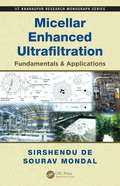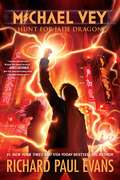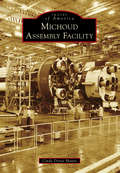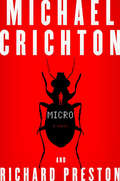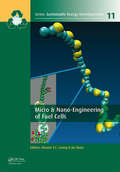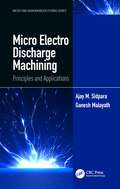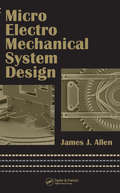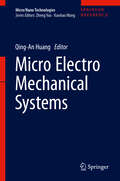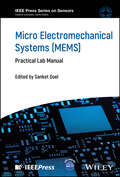- Table View
- List View
Micellar Enhanced Ultrafiltration: Fundamentals & Applications (IIT Kharagpur Research Monograph Series)
by Sirshendu De Sourav MondalA response to increasingly stringent regulation of pollution and toxicity levels in industrial waste discharge, Micellar Enhanced Ultrafiltration: Fundamentals & Applications offers the most complete book available on the benefits and use of micellar-enhanced ultrafiltration (MEUF) to achieve continuous removal of organic and inorganic pollutan
Michael Balz: Schalen und Visionen
by John ChiltonDieses Buch gibt einen Überblick über das Werk des Architekten Michael Balz, dem Pionier der Betonschalenarchitektur. Es behandelt seine realisierten und nicht realisierten Projekte, von denen viele in Zusammenarbeit mit dem renommierten Schweizer Ingenieur Heinz Isler entworfen wurden.Michael Balz. Schalen und Visionen ist reichlich mit Originalzeichnungen und Fotos illustriert: Schalen und Visionen trägt dem zunehmenden Interesse am Entwurf und der Konstruktion von Stahlbeton-Freiformschalen Rechnung, das mit dem Aufkommen von 3D-Modellierungs- und Formfindungssoftware einhergeht. Das Buch beschreibt architektonische Entwürfe und praktische Konstruktionsfragen, um zeitgenössische Schalendesigner zu motivieren.Balz' Erfahrung im Umgang mit Schwierigkeiten wie der Unvereinbarkeit mit nicht-strukturellen Merkmalen und dem Einbau von Fenstern in Schalen sowie der Bewertung der langfristigen Leistungsfähigkeit von Gebäuden ermöglicht es den Lesern, leichterzu lernen, wie sie mit solchen Problemen bei ihrer eigenen Arbeit umgehen können.Das Buch stellt Michael Balz vor, seine frühe Arbeit mit anderen Architekten, einschließlich seiner Arbeit an pneumatischen Formen mit Frei Otto, und seine Entwicklung zu einem Vertreter der organischen Architektur. Anschließend werden realisierte Projekte besprochen, darunter das Theater unter den Kuppeln (1976), der Ballettsaal (1979) und das Haus Balz (1981). Wettbewerbe, an denen Balz teilgenommen hat, und nicht realisierte Rohbauprojekte finden ebenfalls Beachtung, ebenso wie seine Arbeiten im städtischen Maßstab, wobei die konzeptionellen Entwürfe für Megastädte im Mittelpunkt stehen. Seine visionären Megastrukturen ermutigen Architekten, angesichts der zunehmenden Urbanisierung innovative Lösungen für den Stadtraum zu finden. Michael Balz: Schalen und Visionen wird für Studenten und Fachleute aus den Bereichen Architektur, Bauingenieurwesen, Bauwesen und Stadtplanung vonInteresse sein. Die Überlegungen zu den kulturellen und kontextuellen Aspekten von Balz' Werk werden dem Architekturhistoriker helfen, seine langfristige Bedeutung zu schätzen.
Michael Balz: Shells and Visions
by John ChiltonThis book presents a review of the work of the architect Michael Balz, pioneer of concrete-shell architecture. It discusses his projects, both realized and unbuilt, many being designed in collaboration with the renowned Swiss engineer Heinz Isler.Profusely illustrated with original drawings and photographs, Michael Balz: Shells and Visions caters to the increasing interest in the design and construction of free-form reinforced concrete shells consequent on the advent of 3D modelling and form-finding software. The book describes architectural designs and practical construction issues to motivate contemporary shell designers.Balz’s experience of dealing with such difficulties as incompatibility with non-structural features and the insertion of windows into shells, and the assessment of buildings’ long-term performance allow readers to learn more easily how to cope with such issues in their own work.The book introduces Michael Balz, his early work with other architects, including his work on pneumatic forms with Frei Otto, and his evolution into an exponent of organic architecture. It then discusses completed projects, including the outdoor Theater unter den Kuppeln (1976), Ballettsaal (1979) and Balz House (1981). Competitions Balz entered and unrealized shell projects also receive attention, as does his work on the urban scale, highlighting conceptual designs of mega-cities. His visionary megastructures encourage the exploration of innovative solutions for city spaces by architects faced with today’s increased urbanization. Michael Balz: Shells and Visions will be of interest to students and professionals in the fields of architecture, structural engineering, building and urban design. It’s reflections on the cultural and contextual aspects of Balz’s work will help the architectural historian to appreciate its long-term significance.
Michael Collins: A Life
by Dr James MackayThe most charismatic figure to emerge during the struggles for the independence of Ireland was undoubtedly Michael Collins. This remarkable biography, which draws on much hitherto unpublished material, charts the dramatic rise of the country boy who became head of the Free State and the commander-in-chief of the army.
Michael Polanyi and His Generation: Origins of the Social Construction of Science
by Mary Jo NyeIn Michael Polanyi and His Generation, Mary Jo Nye investigates the role that Michael Polanyi and several of his contemporaries played in the emergence of the social turn in the philosophy of science. This turn involved seeing science as a socially based enterprise that does not rely on empiricism and reason alone but on social communities, behavioral norms, and personal commitments. Nye argues that the roots of the social turn are to be found in the scientific culture and political events of Europe in the 1930s, when scientific intellectuals struggled to defend the universal status of scientific knowledge and to justify public support for science in an era of economic catastrophe, Stalinism and Fascism, and increased demands for applications of science to industry and social welfare. At the center of this struggle was Polanyi, who Nye contends was one of the first advocates of this new conception of science. Nye reconstructs Polanyi's scientific and political milieus in Budapest, Berlin, and Manchester from the 1910s to the 1950s and explains how he and other natural scientists and social scientists of his generation--including J. D. Bernal, Ludwik Fleck, Karl Mannheim, and Robert K. Merton--and the next, such as Thomas Kuhn, forged a politically charged philosophy of science, one that newly emphasized the social construction of science.
Michael Vey 3: Battle of the Ampere (Michael Vey #3)
by Richard Paul EvansThe hair-raising action continues for Michael Vey in this charged third installment of the #1 New York Times bestselling series.Michael, Taylor, Ostin and the rest of the Electroclan have destroyed the largest of the Elgen Starxource plants, but now they’re scattered across the Amazon jungle. The Elgen have joined forces with the Peruvian army to capture the Electroclan, and only Michael has managed to remain free. With his friends due to stand trial for terrorism—a charge that may carry the death penalty—Michael will need all his wits and his abilities if he’s to save them. Meanwhile, on the other side of the world, Dr. Hatch and his loyal Electric Children have seized control of the E.S. Ampere—the super yacht the Elgen use as their headquarters. With the Elgen fleet now under his control, Hatch heads back to Peru to pick up his army and then begin his quest for global domination. Michael will have to free his friends then find a way to stop Hatch, but the organization behind the mysterious voice that has guided him to this point has been compromised. Hatch knows Michael and the Electroclan are coming. And he’s ready for them. Can the Electroclan win the battle of the Ampere? Or has Michael’s luck finally run out?
Michael Vey 4: Hunt for Jade Dragon (Michael Vey #4)
by Richard Paul EvansMichael and his friends must rescue a child prodigy as the thrilling action continues in this electrifying fourth installment of the New York Times bestselling series!Michael, Taylor, Ostin and the rest of the Electroclan head to China in search of a girl who may have discovered why Michael and his friends became electric. Her name is Lin Julung, or Jade Dragon, and she’s a child prodigy with an IQ higher than Einstein’s—and Ostin’s. But Hatch gets to her first, and the Elgen are holding her prisoner in their Taiwan Starxource plant. Now the Voice wants Michael and the Electroclan to go to Taiwan and free her before Hatch can realize his dreams of an army of electric children. The hunt for Jade Dragon is on, and it’s a race against time!
Michael Vey 6: Fall of Hades (Michael Vey #6)
by Richard Paul EvansMichael and his friends try to recruit Hatch&’s Electric Youth to their side as the thrilling action continues in this electrifying sixth installment of the New York Times bestselling series!Michael and the Electroclan are about to embark on their deadliest mission yet. Some of them may not make it back. The head of the resistance, known only as the voice, believes that the best way to wipe out the Elgen is to steal their money. That means capturing the Joule, the Elgen boat that serves as a floating treasury. To do this, Michael and his friends need help…a lot of help. They’ve learned about a highly placed member of the Elite Elgen Guard named Welch, who wants to defect. They also know that Hatch has condemned three of his electric youth to death. If the Electroclan can get to Welch before the Elgen do, and if they can rescue Quentin, Torstyn, and Tara, they just might be able to steal the Joule. But it’s a big “if”… The stakes have never been higher, and Michael and his friends are about to be tested in ways they never imagined.
Michaelmas
by Algis BudrysPublished less than a decade into the Internet era, this remarkable science fiction novel foreshadows many of the world&’s technological advances One of the world&’s wealthiest and most influential men, journalist Laurent Michaelmas lives in a penthouse overlooking New York City&’s Central Park with his superintelligent computer, Domino. He attained his fame and power after hacking into the worldwide computer network. He then went on to use his unique gifts to create a version of the UN that would ensure global peace. In short, he and Domino secretly run the world. But now he has reason for concern. A Swiss doctor has cured an astronaut believed to have vaporized in a shuttle explosion during an expedition to the outer planets of the solar system. Suspecting that something extraterrestrial is behind this miraculous recovery, Michaelmas uses his immense influence to launch an international investigation. Are there really aliens in their midst? Is the resurrection of a dead man an attempt to cancel history and destroy the world&’s precarious balance of power?
Michigan Oil and Gas
by Jack R. WestbrookMichigan is commonly recognized as a manufacturing center and for its splendid tourist attractions. Lesser known is Michigan's role as a leader in the production of oil and gas. Since the discovery of commercial quantities of oil in Saginaw in 1925, Michigan has grown to become the 12th-largest natural gas and 17th-largest crude oil producer of the 34 states producing oil and gas. Michigan's petroleum heritage spans 64 of the state's 68 Lower Peninsula counties and has played a role in shielding communities from the financial devastation of the Great Depression, funding acquisition of hundreds of public recreation projects through the Michigan Natural Resources Trust Fund, and rising to meet environmental challenges through improving technologies. Michigan Oil and Gas documents that heritage with photographs from the Clarke Historical Library Norman X. Lyon and Michigan Oil & Gas News Collections.
Michigan's C. Harold Wills: The Genius Behind the Model T and the Wills Sainte Claire Automobile
by Alan Naldrett Lynn Lyon Naldrett Terry ErnestOne of the unsung heroes of the auto world, C. Harold Wills designed the Model T when he worked as Henry Ford's right-hand man. Later, he founded his own company to produce the legendary Wills Sainte Claire. Every endeavor displayed his trademark inventiveness, from the development of the overhead cam engine to the toboggan run on the roof of his house. He used his money to create one of the first worker model cities at Marysville, Michigan. In this long-overdue biography, Alan and Lynn Lyon Naldrett preserve the legacy of an automotive icon.
Michoud Assembly Facility
by Cindy Donze MantoAfter an auspicious beginning as a royal land grant from French king Louis XV to a wealthy French citizen of New Orleans in 1763, the land Michoud Assembly Facility occupies remained in private ownership until 1940, when it was sold to the US government. Prior to World War II, the site was used to grow sugar, hunt muskrat, and build railroad and telephone lines. In 1941, the world's largest industrial site was built, covering 43 acres of unobstructed, low-humidity, air-cooled space under one roof to construct C-46 cargo planes. The Korean War required the assembly of Sherman and Patton tanks there, while the space race compelled the design and assembly of the colossal Saturn I, IB, and V rocket boosters for the Apollo program that reported directly to Dr. Wernher von Braun. The 1970s saw the fabrication of the enormous external tank for the Space Shuttle program. Today, Michoud Assembly Facility continues to support the US space program by building major components for the Orion Multi-Purpose Crew Vehicle (or MPCV).
Micro
by Michael Crichton Richard PrestonIn Jurassic Park, he created a terrifying new world. Now, in Micro, Michael Crichton reveals a universe too small to see and too dangerous to ignore.In a locked Honolulu office building, three men are found dead with no sign of struggle except for the ultrafine, razor-sharp cuts covering their bodies. The only clue left behind is a tiny bladed robot, nearly invisible to the human eye.In the lush forests of Oahu, groundbreaking technology has ushered in a revolutionary era of biological prospecting. Trillions of microorganisms, tens of thousands of bacteria species, are being discovered; they are feeding a search for priceless drugs and applications on a scale beyond anything previously imagined.In Cambridge, Massachusetts, seven graduate students at the forefront of their fields are recruited by a pioneering microbiology start-up. Nanigen MicroTechnologies dispatches the group to a mysterious lab in Hawaii, where they are promised access to tools that will open a whole new scientific frontier.But once in the Oahu rain forest, the scientists are thrust into a hostile wilderness that reveals profound and surprising dangers at every turn. Armed only with their knowledge of the natural world, they find themselves prey to a technology of radical and unbridled power. To survive, they must harness the inherent forces of nature itself.An instant classic, Micro pits nature against technology in vintage Crichton fashion. Completed by visionary science writer Richard Preston, this boundary-pushing thriller melds scientific fact with pulse-pounding fiction to create yet another masterpiece of sophisticated, cutting-edge entertainment.
Micro & Nano-Engineering of Fuel Cells (Sustainable Energy Developments)
by Jin Xuan Dennis Y.C. LeungFuel cells are clean and efficient energy conversion devices expected to be the next generation power source. During more than 17 decades of research and development, various types of fuel cells have been developed with a view to meet the different energy demands and application requirements. Scientists have devoted a great deal of time and effort
Micro / Nano Replication
by Shinill KangAn introduction to micro and nano replication processes and applicationsMicro/Nano Replication: Processes and Applications provides an overview of the fundamentals, processes, and applications involved in micro and nano replication in the manufacturing of product parts. A major field of nanotechnology, the study of micro/nano replication is sure to become one of increasing importance as the construction of completely new devices based on innovative concepts and crafted at the molecular level increases.Designed to help the reader understand and learn to work with the growing number of tools for molding plastic components, the book covers the key topics related to replication, including patterning technology, the modification of mold surface properties, and much more. In addition, it addresses the strengths and weaknesses of different molding processes.With a strong focus not only on how micro/nano replication works, but also the broader implications for the industry, the book is packed with examples of real world applications. These are drawn from a variety of fields, including information storage devices, optoelectronic elements, optical communication, and biosensors, in order to provide a complete view of the importance of micro and nano processes.A valuable introduction to a new but fast-growing field, Micro/Nano Replication is an essential resource for anyone looking to get a head start on understanding this emerging discipline.
Micro Electro Discharge Machining: Principles and Applications (Micro and Nanomanufacturing Series)
by Ajay M. Sidpara Ganesh MalayathMicro Electro Discharge Machining (EDM) is a prominent technology for the fabrication of micro components in many fields. Nowadays, it is used like a conventional machine tool due to favorable characteristics. This book provides the fundamental knowledge of the principles of the process and its variants, the different process parameters, the role of machine components and systems, the challenges, and how to eliminate processing errors. It also includes real life applications of micro EDM in different areas with the most relevant examples.
Micro Electro Mechanical System Design (Mechanical Engineering)
by James J. AllenIt is challenging at best to find a resource that provides the breadth of information necessary to develop a successful micro electro mechanical system (MEMS) design. Micro Electro Mechanical System Design is that resource. It is a comprehensive, single-source guide that explains the design process by illustrating the full range of issues involved,
Micro Electro Mechanical Systems (Micro/nano Technologies Ser. #2)
by Qing-An HuangThis handbook volume aims to provide a comprehensive, self-contained, and authoritative reference in MEMS. It covers the theoretical and practical aspects including but not limited to sensors, actuators, RF MEMS, micro fluids and bio MEMS systems. It is particularly recommended to undergraduates, postgraduates, researchers, scientists, and field experts. This comprehensive summary will provide a solid knowledge background and inspire innovations in this highly interdisciplinary field.The handbook series consists of 5 volumes: Micro/nano fabrication technology, MEMS, Nanomaterial, Nanomedicine and Applications of micro-/nanotechnologies in IT. Experienced researchers and experts are invited to contribute in each of these areas.The series is published under Springer Major Reference works, which allows continuous online update and publication. These features allow newcomers and other readers to keep in touch with the most up-to-date information in micro-/nanotechnologies.It presents an overview of the knowledge base, as well as selected topics and provides comprehensive and authoritative information on the field for researchers, engineers, scientists and graduate students who are involved in different aspects of micro-/nanotechnologies.This publication will provide inspiration for innovative research and application ideas for continued growth of the field.
Micro Electromechanical Systems: Practical Lab Manual (IEEE Press Series on Sensors)
by Abhishek Kumar Sanjeet Kumar Khairunnisa Amreen Manish Bhaiyya Pavar Sai KumarPractical lab manual on the stepwise description of the experimental procedures of micro electromechanical systems (MEMS) devices Micro Electromechanical Systems (MEMS) is a highly practical lab manual on the relevant experimental procedures of MEMS devices, covering technical aspects including simulations and modeling, practical steps involved in fabrication, thorough characterizations of developed MEMS sensors, and leveraging these sensors in real-time targeted applications. The book provides in-depth coverage of multi-physics modeling for various sensors, as well as fabrication methodologies for photolithography, soft lithography, 3D printing, and laser processing-based experimental details for the realization of MEMS devices. It also covers characterization techniques from morphological to compositional, and applications of MEMS devices in contemporary fields such as microfluidics, wearables, and energy harvesters. The text also includes a foundational introduction to the subject. The book covers additional topics such as: Basic fluid flow and heat transfer in microfabrication, Y and T channel mixing, and simulation processes for Droplet generationSimulations based on cyclic voltammetry and electrochemical impedance spectroscopy, screen and ink-jet printing, laser-induced graphene, reduced graphene oxide, and 3D printingX-ray diffraction, scanning electron microscopy, optical microscopy, Raman spectroscopy, energy dispersive spectroscopy, and Fourier Transform Infrared (FTIR) Spectroscopy Experimental stepwise details to enable students to perform the experiments in the practical laboratory and future outlooks on the direction of the field A practical guidebook on the subject, Micro Electromechanical Systems (MEMS) is a must-have resource for students, academicians, and lab technicians seeking to conduct experiments in real-time.
Micro Energy Harvesting
by Danick Briand Gary K. Fedder Osamu Tabata Christofer Hierold Eric Yeatman Shad Roundy Jan G. Korvink Oliver BrandWith its inclusion of the fundamentals, systems and applications, this reference provides readers with the basics of micro energy conversion along with expert knowledge on system electronics and real-life microdevices. The authors address different aspects of energy harvesting at the micro scale with a focus on miniaturized and microfabricated devices. Along the way they provide an overview of the field by compiling knowledge on the design, materials development, device realization and aspects of system integration, covering emerging technologies, as well as applications in power management, energy storage, medicine and low-power system electronics. In addition, they survey the energy harvesting principles based on chemical, thermal, mechanical, as well as hybrid and nanotechnology approaches. In unparalleled detail this volume presents the complete picture -- and a peek into the future -- of micro-powered microsystems.
Micro Irrigation Systems in India
by P. K. Viswanathan M. Dinesh Kumar A. NarayanamoorthyThis book takes stock of micro irrigation systems (MIS), the technological intervention in India's agricultural and water management sectors, over the past couple of decades. Based on empirical research from the major agriculturally dynamic states, viz. , Gujarat, Rajasthan, Maharashtra, Tamil Nadu, Andhra Pradesh and Karnataka, the book provides a nuanced understanding and objective assessment of the implementation and adoption of MIS across these states. It addresses several of the questions related to adoption and impacts of MIS in India. On the adoption side, the key question that the book addresses is which segment of the farming community adopts MIS across states? The impacts analysed include those on physical, agronomic and economic aspects. At the macro level, the question being asked is about the future potential of MIS in terms of saving water from agriculture and making more water available for environment. The book also addresses the question of the positive/negative externalities and real social benefits and costs from the use of MIS, a major justification for heavy capital subsidies for its purchase by farmers. It also brings out certain critical concerns pertaining to MIS adoption, which need to be addressed through more empirical research based on longitudinal panel/ cross sectional data. The book would be of great use to researchers (agricultural water management, irrigation economics), students of water resource engineering, irrigation engineering and water resources management, as well as to policy makers and agricultural water management experts - national and international.
Micro Light Emitting Diode: Micro-LED Technology (Series in Display Science and Technology)
by Jong-Hyun Ahn Jae-Hyun KimThis book focuses on basic fundamental and applied aspects of micro-LED, ranging from chip fabrication to transfer technology, panel integration, and various applications in fields ranging from optics to electronics to and biomedicine. The focus includes the most recent developments, including the uses in large large-area display, VR/AR display, and biomedical applications. The book is intended as a reference for advanced students and researchers with backgrounds in optoelectronics and display technology. Micro-LEDs are thin, light-emitting diodes, which have attracted considerable research interest in the last few years. They exhibit a set of exceptional properties and unique optical, electrical, and mechanical behaviors of fundamental interest, with the capability to support a range of important exciting applications that cannot be easily addressed with other technologies. The content is divided into two parts to make the book approachable to readers of various backgrounds and interests. The first provides a detailed description with fundamental materials and production approaches and assembly/manufacturing strategies designed to target readers who seek an understanding ofof essential materials and production approaches and assembly/manufacturing strategies designed to target readers who want to understand the foundational aspects. The second provides detailed, comprehensive coverage of the wide range of device applications that have been achieved. This second part targets readers who seek a detailed account of the various applications that are enabled by micro-LEDs.
Micro Metal Forming
by Frank VollertsenMicro Metal Forming, i. e. forming of parts and features with dimensions below 1 mm, is a young area of research in the wide field of metal forming technologies, expanding the limits for applying metal forming towards micro technology. The essential challenges arise from the reduced geometrical size and the increased lot size. In order to enable potential users to apply micro metal forming in production, information about the following topics are given:tribological behavior: friction between tool and work piece as well as tool wearmechanical behavior: strength and formability of the work piece material, durability of the work pieces size effects: basic description of effects occurring due to the fact, that the quantitative relation between different features changes with decreasing size process windows and limits for forming processestool making methodsnumerical modeling of processes and process chainsquality assurance and metrologyAll topics are discussed with respect to the questions relevant to micro metal forming. The description comprises information from actual research and the young history of this technology branch to be used by students, scientists and engineers in industry who already have a background in metal forming and like to expand their knowledge towards miniaturization. tribological behavior: friction between tool and work piece as well as tool wearmechanical behavior: strength and formability of the work piece material, durability of the work pieces size effects: basic description of effects occurring due to the fact, that the quantitative relation between different features changes with decreasing size process windows and limits for forming processestool making methodsnumerical modeling of processes and process chainsquality assurance and metrologyAll topics are discussed with respect to the questions relevant to micro metal forming. The description comprises information from actual research and the young history of this technology branch to be used by students, scientists and engineers in industry who already have a background in metal forming and like to expand their knowledge towards miniaturization.
Micro Process and Quality Control of Plasma Spraying (Springer Series in Advanced Manufacturing)
by Haidou Wang Guozheng Ma Shuying ChenThis book focuses on the basic physical process and chemical reaction of plasma spraying particle melting, flight and deposition. It introduces the basic scientific contents such as the basic characteristics and spraying principle of plasma arc, the interaction between spraying particles in flight section and plasma jet, the spreading and solidification behavior of single droplet and the performance test of flat particles, macro performance evaluation and quality optimization of coating. The typical applications of plasma spraying coating and the new developing direction of plasma spraying technology are summarized. This book will be helpful for the graduate students, researchers, as well as engineers in the field of plasma spray.
Micro Reaction Technology in Organic Synthesis
by Paul Watts Charlotte WilesWhile continuous processes have found widespread application within chemical production, members of the research and development communities have historically favored the centuries old technique of iterative batch reactions. With the exception of combinatorial and microwave chemistry, little had been done to change the way that synthetic chemists c
